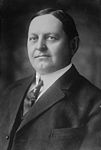United States Senate elections, 1918
|
|
|||||||||||||||||||||||||||||||
|---|---|---|---|---|---|---|---|---|---|---|---|---|---|---|---|---|---|---|---|---|---|---|---|---|---|---|---|---|---|---|---|
|
|||||||||||||||||||||||||||||||
|
32 of the 96 seats in the U.S. Senate (as well as special elections) 49 seats needed for a majority |
|||||||||||||||||||||||||||||||
|
|||||||||||||||||||||||||||||||

Results including special elections
Democratic gains Republican gains Democratic holds Republican holds |
|||||||||||||||||||||||||||||||
|
|||||||||||||||||||||||||||||||
Thomas S. Martin
(as Conference Chairman)
Democratic
Henry Cabot Lodge
(Unofficial)
Republican
The United States Senate elections of 1918 were held November 5, 1918 coinciding with the midpoint of Woodrow Wilson's second term as President of the United States. The Republican Party gained control with a slim 2-seat majority after picking up a net six seats. The change in control was particularly important, as it meant that the Republicans were in a position to deny entry of the United States into the League of Nations, the centerpiece of Wilson's post-war foreign policy. It was the first election in which all Class 2 senators were subject to direct election following the enactment of the Seventeenth Amendment, making them the final class under the old system.
Republicans gained seven seats:
Democrats gained one seat:
Majority Party: Republican (49 seats)
Minority Party: Democratic (47 seats)
Other Parties: 0
Total Seats: 96
Source: United States Senate Official Website
Note: These numbers represent composition as result of 1918 Senatorial Elections. Actual composition often changes during term, due to deaths, resignations or party shifting.
Before the November 5, 1918 general election.
In these special elections, the winner was seated during 1918 or before March 4, 1919; ordered by election date.
In these general elections, the winners were elected for the term beginning March 4, 1919; ordered by state.
All of the elections involved the Class 2 seats.
There were no elections in 1919.
...
Wikipedia


